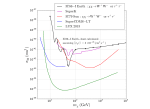The IceCube Collaboration presents an update to previous GRB searches and broadens the search to the Southern Hemisphere using data through May 2015. The inspection of the southern sky increases the sensitivity to the highest-energy neutrinos, which are largely absorbed before reaching IceCube after sailing through the Earth. Researchers looked for neutrino emission in conjunction with prompt gamma-ray emission from 1172 GRBs and did not find any significant correlation with neutrinos detected in IceCube. These results set the strongest constraints yet on GRBs as primary sources of UHECRs. This study has just been submitted to The Astrophysical Journal. […]
Research
Multiwavelength follow-up program passes the stress test of a neutrino triplet
On February 17, 2016, IceCube detected the most significant multiplet since the start of the optical follow-up program: three neutrinos appearing within 100 seconds and consistent with a point source origin. This rare neutrino coincidence has allowed further testing of the capabilities of the IceCube follow-up program, which is able to trigger observations in near real time to search for transient sources. These results have been submitted today to the journal Astronomy & Astrophysics. […]
Searching for sterile neutrinos with DeepCore
The IceCube Collaboration has continued the hunt for sterile neutrinos with a search using lower energy atmospheric neutrinos. This new search looked into three years of IceCube data and again has not found any hint of a light sterile neutrino. These results have been submitted today to Physical Review D. […]
Solar dark matter continues hiding from IceCube
The IceCube Collaboration has recently presented an update to the search for dark matter annihilation in the sun using the first three years of data with the completed detector. The search, which again did not find evidence of neutrinos originating from dark matter annihilations, has now improved these limits by a factor of 2 to 4. These are again the most stringent limits on the spin-dependent dark-matter–proton scattering for WIMP masses above 50 GeV. This study was submitted to the European Physical Journal C. […]
‘Ghost particles’ could improve understanding the universe
New measurements of neutrino oscillations, observed at the IceCube Neutrino Observatory at the South Pole, have shed light on outstanding questions regarding fundamental properties of neutrinos. These new measurements of neutrinos as they change from one type to another while they travel were presented at the American Physical Society Meeting in Washington. […]
Everything you always wanted to know about the IceCube detector
For the first time, the IceCube Collaboration is making public every detail of the only cubic-kilometer neutrino detector to date, from a flasher board in the digital optical modules—aka DOMs—to the calibration processes that allow researchers to measure the properties of neutrinos, or to the IceCube Live website that IceCubers use to monitor what is going on in the detector. The publication, over 70 pages long, has just been submitted to the Journal of Instrumentation. […]
Exploring blazars as astrophysical neutrino sources
A new study from the IceCube Collaboration searched in three years of IceCube data for directional clustering of neutrinos around gamma-ray sources associated with blazars from the second Fermi-LAT AGN catalog. Although some enhancements in the observed neutrino rate from these blazars were found in the 3–30 TeV region, all of them are compatible with fluctuations of the atmospheric neutrino background. These results, recently submitted to The Astrophysical Journal, open several new analyses exploring blazars as very high energy neutrino sources. […]
Neutrinos and gamma rays, a partnership to explore the extreme universe
IceCube’s collaborative efforts with gamma-ray, X-ray, and optical telescopes started long ago. Now, the IceCube, MAGIC and VERITAS collaborations present updates to their follow-up programs that will allow the gamma-ray community to collect data from specific sources during periods when IceCube detects a higher number of neutrinos. Details of the very high energy gamma-ray follow-up program have been submitted to the Journal of Instrumentation. […]
Searching for point-like sources with seven years of IceCube data
The IceCube Collaboration has just announced the results of a search for point-like sources using track-like neutrino candidates detected by IceCube over seven years, from 2008 to 2015. No source has been identified, but the sensitivity keeps improving at a fast pace and will allow IceCube to test accurate models that suggest that sources could soon be observed. These results have just been submitted to The Astrophysical Journal. […]
Searching for dark matter in the Earth
The IceCube Collaboration has expanded dark matter studies with a search for annihilations in the center of the Earth. Researchers have used one year of data—May 2011 to May 2012—and have not found an excess of neutrinos above the expected background. The results have set new limits on the annihilation rate of WIMPs in the Earth that are an order of magnitude stronger than previous results by AMANDA and that also improve the IceCube spin-independent cross section limits for a WIMP mass of 50 GeV. This study has just been submitted to The European Physical Journal C. […]









